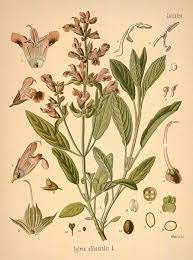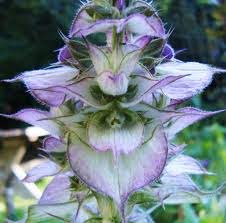As its essential oil is non-toxic and non-irritant, clary sage (Salvia sclarea) is the sage variety most used in aromatherapy. The clary sage plant is quite different in appearance to common sage; it is a biennial herb growing up to 1m with large, rather coarse, hairy leaves at the base of the plant.

Its small flowers resemble a half-open beak, and are pinkish-white through blue to mauve. The fragrance changes as the plant ages; in the early growing stages it has a somewhat lemony, tangy smell, which develops as the plant reaches maturity to become more mellow and sweet.
Heady History
The fragrance of the mature plant is reflected in one of its common names, Muscatel sage, and it was once grown in German vineyards, possible to augment wine production and improve the bouquet of the wines. When introduced to England in the 16th century, it was occasionally added to beer or ale to make it more heady; 'fit to please drunkards who thereby... became either dead drunke, or foolish drunke or madde drunke', as one 18th century writer stated. However, the name - from the Latin clarus - means clear, and was probably due to its traditional use as a remedy for clearing mucous and irritants from the eyes. It was also a popular remedy among medieval herbal practitioners as an aid to digestion, and in the treatment of women's problems and kidney ailments.
Native to Italy, Syria and the south of France, clary sage will grow in most areas if the soil is dry enough. Today, it is cultivated commercially in France, Morocco and Russia, and the essential oil is extracted from the freshly-harvested flowering tops by steam distillation. Once the essential oil has been extracted, the dried herb material is further treated by chemicals to produce a fixative, valued in the perfume industry. The final stage in the life of clary sage plants is the sale of the spent plant material to compost manufacturers.

Not everyone likes the fragrance of clary sage but, used sparingly, it gives warmth to a blend and adds depth and subtlety. It is a complicated blend of sweet, light and herbaceous notes with warm, almost earthy, tones.
This complexity of fragrance is a reflection of the chemical composition of the oil, which contains over 250 different constituents. Clary sage can sometimes leave you feeling high so leave some time after using it for relaxation.
Properties of the Oil
The chemical constituents of clary sage are predominantly relaxing; it is a great tonic for the nervous system and acts as an antidepressant. Of particular interest is the fact that the oil contains a small percentage (1% to 7%) of a constituent called sclareol. This oestrogen-like substance accounts for why the essential oil is recommended for hormonal probelms.
Oestrogens maintain the normal function of the female reproductive organs and are controlled by the pituitary, often called the body's 'master gland'. Apart from influencing the reproductive and other hormonal glands, the pituitary links closely with the nervous system, which can in turn by strongly influenced by emotions. This chain explains how the cause of many problems of the reproductive system is often both physical and psychological. So clary sage oil has a multi-dimensional action on the mind and body, which can be a gentle yet powerful remedy for hormonal problems.
Restoring the Balance
Due to its apparent regulating influence on the pituitary gland, clary sage oil is recommended for all imbalances of the menstrual cycle, including painful, heavy or scanty periods. For premenstrual pain it is effective when combined with lavender or in hot compresses and applied to the abdomen.

Alternatively, make a massage oil from clary sage, geranium, lavender, marjoram or cypress oil, and include a small amount of evening primrose or borage oil to help regulate periods and relieve pain. For menopausal symptoms, such as hot flushes, night sweats and emotional lows, clary sage is also recommended in combination with essential oils such as geranium, cypress and citrus (1 drops of each essential oil to 20ml carrier oil).
Circulatory problems, such as varicose veins, are sometimes linked to hormonal imbalance, although a tendency to such conditions may be hereditary. Treatments, or preferably preventative measures, need to be regular and frequent. Choose from clary sage, geranium, cypress, lemon or juniper berry essential oils, and blend in a body lotion for a daily application, or with a carrier oil for a massage blend (use 11 drops only of the combined essential oils to 50ml body lotion/carrier oil).
Clary sage has also been recommended for the relief of depression, whether linked to hormonal imbalances or not. You need to take care as the elation created by clary sage can turn to drowsiness if you use too much. It is worth remembering that we respond to fragrance even at a subconscious level, so start by using less rather than more. Good companions with clary sage oil for lifting the spirits are bergamot, neroli, grapefruit, geranium or frankincense oil.